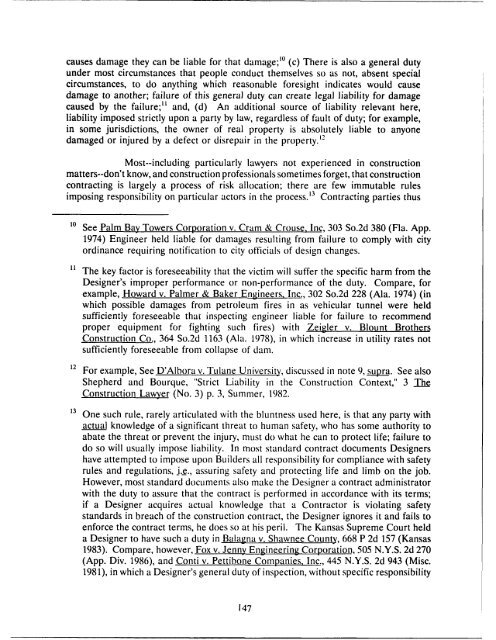Challenges and Opportunities for Innovation in the Public Works ...
Challenges and Opportunities for Innovation in the Public Works ...
Challenges and Opportunities for Innovation in the Public Works ...
You also want an ePaper? Increase the reach of your titles
YUMPU automatically turns print PDFs into web optimized ePapers that Google loves.
causes damage <strong>the</strong>y can be liable <strong>for</strong> that damage;'° (c) There is also a general duty<br />
under most circumstances that people conduct <strong>the</strong>mselves so as not, absent special<br />
circumstances, to do anyth<strong>in</strong>g which reasonable <strong>for</strong>esight <strong>in</strong>dicates would cause<br />
damage to ano<strong>the</strong>r; failure of this general duty can create legal liability <strong>for</strong> damage<br />
caused by <strong>the</strong> failure;" <strong>and</strong>, (d) An additional source of liability relevant here,<br />
liability imposed strictly upon a party by law, regardless of fault of duty; <strong>for</strong> example,<br />
<strong>in</strong> some jurisdictions, <strong>the</strong> owner of real property is absolutely liable to anyone<br />
damaged or <strong>in</strong>jured by a defect or disrepair <strong>in</strong> <strong>the</strong> property.' 2<br />
Most--<strong>in</strong>clud<strong>in</strong>g particularly lawyers not experienced <strong>in</strong> construction<br />
matters--don't know, <strong>and</strong> construction professionals sometimes <strong>for</strong>get, that construction<br />
contract<strong>in</strong>g is largely a process of risk allocation; <strong>the</strong>re are few immutable rules<br />
impos<strong>in</strong>g responsibility on particular actors <strong>in</strong> <strong>the</strong> process.'" Contract<strong>in</strong>g parties thus<br />
'0 See Palm Bay Towers Corporation v. Cram & Crouse, Inc, 303 So.2d 380 (Fla. App.<br />
1974) Eng<strong>in</strong>eer held liable <strong>for</strong> damages result<strong>in</strong>g from failure to comply with city<br />
ord<strong>in</strong>ance requir<strong>in</strong>g notification to city officials of design changes.<br />
' The key factor is <strong>for</strong>eseeability that <strong>the</strong> victim will suffer <strong>the</strong> specific harm from <strong>the</strong><br />
Designer's improper per<strong>for</strong>mance or non-per<strong>for</strong>mance of <strong>the</strong> duty. Compare, <strong>for</strong><br />
example, Howard v. Palmer & Baker Eng<strong>in</strong>eers, Inc., 302 So.2d 228 (Ala. 1974) (<strong>in</strong><br />
which possible damages from petroleum fires <strong>in</strong> as vehicular tunnel were held<br />
sufficiently <strong>for</strong>eseeable that <strong>in</strong>spect<strong>in</strong>g eng<strong>in</strong>eer liable <strong>for</strong> failure to recommend<br />
proper equipment <strong>for</strong> fight<strong>in</strong>g such fires) with Zeigler v. Blount Bro<strong>the</strong>rs<br />
Construction Co., 364 So.2d 1163 (Ala. 1978), <strong>in</strong> which <strong>in</strong>crease <strong>in</strong> utility rates not<br />
sufficiently <strong>for</strong>eseeable from collapse of dam.<br />
12 For example, See D'Albora v. Tulane University, discussed <strong>in</strong> note 9, supra. See also<br />
Shepherd <strong>and</strong> Bourque, "Strict Liability <strong>in</strong> <strong>the</strong> Construction Context," 3 The<br />
Construction Lawyer (No. 3) p. 3, Summer, 1982.<br />
13 One such rule, rarely articulated with <strong>the</strong> bluntness used here, is that any party with<br />
actual knowledge of a significant threat to human safety, who has some authority to<br />
abate <strong>the</strong> threat or prevent <strong>the</strong> <strong>in</strong>jury, must do what he can to protect life; failure to<br />
do so will usually impose liability. In most st<strong>and</strong>ard contract documents Designers<br />
have attempted to impose upon Builders all responsibility <strong>for</strong> compliance with safety<br />
rules <strong>and</strong> regulations, j.e., assur<strong>in</strong>g safety <strong>and</strong> protect<strong>in</strong>g life <strong>and</strong> limb on <strong>the</strong> job.<br />
However, most st<strong>and</strong>ard documents also make <strong>the</strong> Designer a contract adm<strong>in</strong>istrator<br />
with <strong>the</strong> duty to assure that <strong>the</strong> contract is per<strong>for</strong>med <strong>in</strong> accordance with its terms;<br />
if a Designer acquires actual knowledge that a Contractor is violat<strong>in</strong>g safety<br />
st<strong>and</strong>ards <strong>in</strong> breach of <strong>the</strong> construction contract, <strong>the</strong> Designer ignores it <strong>and</strong> fails to<br />
en<strong>for</strong>ce <strong>the</strong> contract terms, he does so at his peril. The Kansas Supreme Court held<br />
a Designer to have such a duty <strong>in</strong> Balagna v. Shawnee County, 668 P 2d 157 (Kansas<br />
1983). Compare, however, Fox v. Jenny Eng<strong>in</strong>eer<strong>in</strong>g Corporation, 505 N.Y.S. 2d 270<br />
(App. Div. 1986), <strong>and</strong> Conti v. Pettibone Companies, Inc., 445 N.Y.S. 2d 943 (Misc.<br />
1981), <strong>in</strong> which a Designer's general duty of <strong>in</strong>spection, without specific responsibility<br />
147







